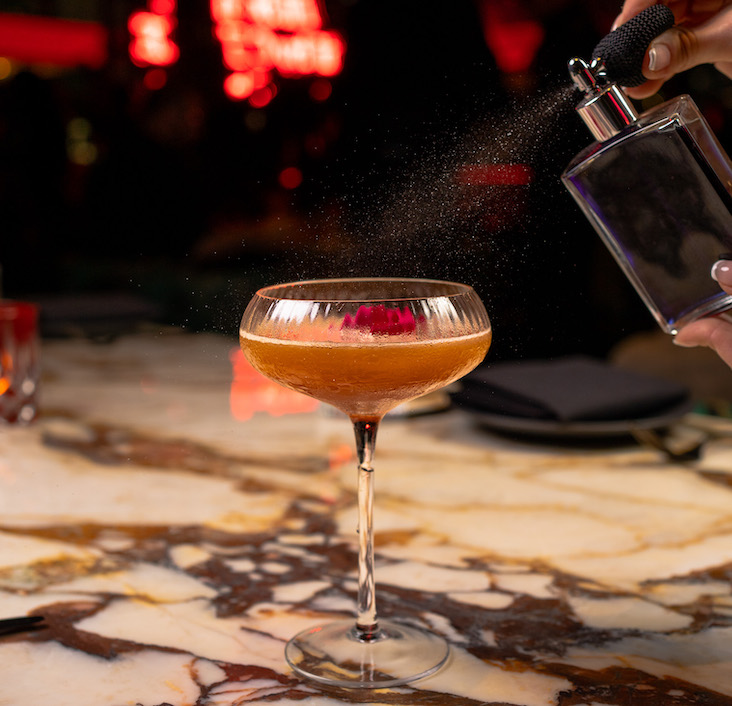Complex flavors have helped create a new generation of refreshing iced teas and coffees.
John Harding of Restaurant Associates hoists one of the group’s winning iced coffees at Tropica Bar & Grill.
photography by Steve Skoll
by Rona Gindin
YOU’VE ALREADY BOOSTED CHECK AVERAGES by developing your single malt Scotch and flavored latte business; how else can you improve your operation’s image, enhance customer satisfaction and bring in an extra buck or two per check?
Think basics. You can’t just serve the same old boring iced tea and coffee anymore and compete with the still-growing coffee shop operators. The combination of product innovations, greater customer coffee and tea awareness and current upscaling trends can offer quick-moving restaurateurs a range of opportunities. Start with great ingredients, add unusual preparation and service twists, and you can inexpensively develop a signature non-alcohol beverage program.
Sales of iced non-alcohol beverages have been growing steadily in the restaurant environment. Iced tea alone reached $1.75 million in foodservice establishments in 1997, up from $500 million only seven years earlier, according to the Tea Council of the USA.
While iced tea has long been an American standard–85% of the tea consumed in this country is iced, according to the Tea Council–iced coffee has until recently been consumers’ dirty little secret. Restaurateurs often pour hot coffee over ice cubes, leaving a diluted, and uninteresting, beverage. Order an ordinary iced coffee at a trendy coffeehouse, and you’re bound to be sneered at by a coffee-snob who works behind the counter.
But while iced coffee consumption has been flat (according to the National Coffee Association 1997 Winter Coffee Study, only four-tenths of 1% of Americans said they drink the stuff), recent foodservice initiatives indicate that sales have started to take off, as the beverage has emerged in such new forms as iced cappuccino, mochaccino and lattes. Consumers seem to have welcomed the developments in both beverages.
GIVE TEAS A CHANCE
The iced tea revolution seems to have started with bottled, flavored iced tea beverages, such as Snapple, which reintroduced consumers to a traditional all-American product and added fruit flavors.
Encouraged by the success of its iced coffee program, Starbucks has recently introduced iced Chai Tea Latte, flavoring a honey-sweetened black tea with ginger, cinnamon, cloves and nutmeg and blending in milk. Chai varieties made by Oregon Chai and other manufacturers are beginning to grab space in supermarkets as well.
Starbucks may be one of the most innovative purveyors of iced beverages in the nation, but it’s not the only one. At the Phoenician, a destination resort in Phoenix, AZ, the Phoenician Iced Tea has been a signature drink throughout the hotel for at least a decade. Iced tea is mixed with lemonade, then sweetened with a drop of prickly pear cactus syrup and garnished with a lemon.
“The prickly pear syrup gives guests a taste of the southwest,” explains spokesperson Sally Cooper. She says the beverage sells strongly at lunch and throughout the afternoon, offering a sweet, refreshing alternative to the standard soft drink.
New York’s Restaurant Associates uses a special blend of iced tea in most of its metropolitan area restaurants. Named Panevino Iced Tea after its Italian restaurant, the beverage is made with an ounce of black currant tea steeped in 1-1/2 gallons of boiling water, the skin of one orange and two ounces of Cassis syrup, according to vice president and director of marketing John Harding. “In this business you’re always looking for a signature item that sets your restaurant apart,” he explains. “One of those items is iced tea. We formulated ours years ago to work with our Panevino Italian concept, and now we use it at several of our restaurants.
He says guests find it a refreshing change from soft drinks, which are priced the same. “Unless you order the decaffeinated version, iced tea is a mild pick-me-up,” he points out. “It’s good when people don’t want the sweetness of soft drinks, or the carbon dioxide, which can be filling and gassy.”
Like many operators, Emerson’s, a downtown Los Angeles cafe, is devoted to Paradise Tea, a line of passion fruit and other flavored iced teas. Owner Tarite Tanjasiri says he receives the teas in commercial-size tea bags and brews it hot, three or four gallons at a time each day, then chills it and pours it over ice. “It’s more refreshing than regular iced tea, and it seems to be a better quality tea,” Tanjasiri points out. “It’s also an interesting color and very, very clear, and that draws customers’ attention.”
TEA TIME
“Our iced tea has gotten us write-ups in several magazines and newspapers, and I didn’t even think of it as press worthy,” says Hansj




